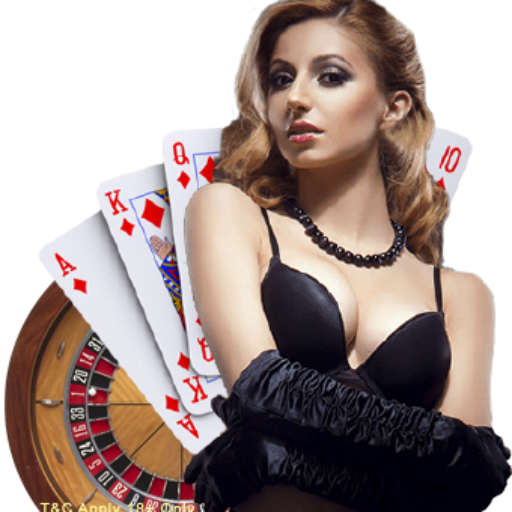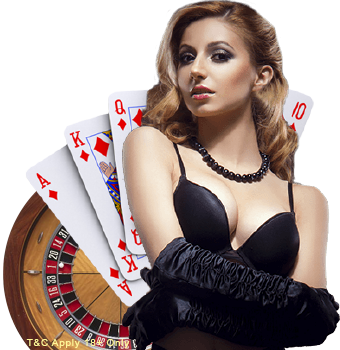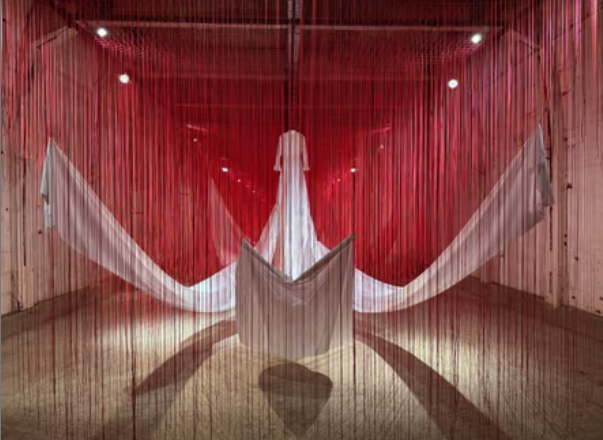Austrian town gets its lederhosen in a twist over modern art
Bad Ischl is the first alpine town to be awarded European capital of culture status, bringing nudity and surreal sculptures to a rural area more in tune with classical music and mountain pursuits
I’m walking through the town of Bad Aussee, in Austria’s alpine Salzkammergut region, where I’m expecting a vision of depravity to emerge through the drizzle. The artists Wolfgang Müllegger and Georg Holzmann gleefully tell me how their big pink sculpture, which was recently placed in the town’s cafe-flanked park, caused shock among locals. Many want it removed, they explain, as we arrive at the artwork. It’s a rather pleasant pastel-pink wooden piece that could depict a pig in a mildly psychedelic kids’ TV show.
I say that the sculpture is completely inoffensive. “It’s just ‘different’,” says Holzmann, wearing a hoodie and yellow waterproof dungarees, like a hipster fisher. He points to a traditional stone statue of a historic figure in the park. “This is what they’re used to.”
The pink sculpture is one of hundreds of exhibitions and events taking place across the region in 2024, thanks to the nearby town of Bad Ischl and the wider Salzkammergut region becoming the first rural alpine destination to get European capital of culture (ECOC) status. The contemporary art influx is a colour blast of creativity in an area that usually attracts tourists interested in historic villas, mountains and high-end lederhosen.
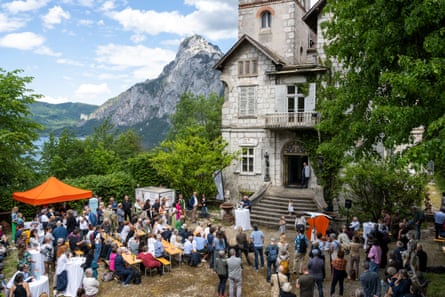
For the project, Vienna-based design studio Lucy.D redesigned rooms in guesthouses across the region, inspired by local craftspeople working with wood and dried grass. Venues previously closed to the public, from semi-derelict mansions to quarries, host exhibitions. Many people say they are invigorated by the buzz. But there have been belligerent reactions from some, who perceive an outsider threat to traditions.
To reach Salzkammergut, I take the Eurostar from London to Brussels, the European Sleeper to Berlin, then overland trains to Bad Ischl. Leaving St Pancras in the early afternoon, I arrive at 6pm the next day, spending the last half-hour travelling down the west flank of the sea-like Traunsee.
Outside Bad Ischl’s train station, I’m greeted by a chrome sculpture by Vienna-born artist Xenia Hausner depicting a gasping woman with a gas tank balanced on her head. It’s a “sensory image of despair”, according to the ECOC blurb, but elsewhere, Austro-Hungarian Emperor Franz Joseph I is very much the face of this town, even though he has been dead since 1916. He and his mutton-chop sideburns are on postcards in every gift shop, and busloads of tourists visit the Kaiservilla: Franz Joseph’s former residence. It’s now a museum currently with a major exhibition of sculptures by Ai Weiwei.
Just past Bad Ischl’s market, where two boys in lederhosen are playing accordions, I come to the white-walled Sudhaus complex. It was once a facility for processing salt, which is almost as important in Bad Ischl as Franz Joseph. Salzkammergut means “salt domain”, and salt has been mined here for thousands of years. The centrepiece of the exhibition at Sudhaus is Motoi Yamamoto’s Labyrinth: an intricate maze created by the Japanese artist using salt grains on the gallery floor. A video by Israeli artist Sigalit Landau, showing boots covered in salt crystals melting into an icy lake, is projected on a wall. Football-sized sculptures of human teeth, carved from rock salt, litter the ground.
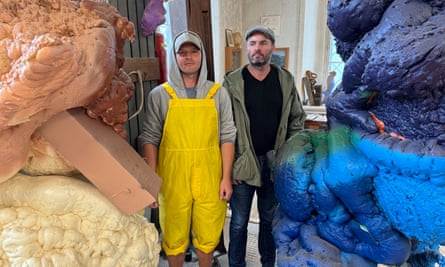
Many Salzkammergut residents I meet agree that this ECOC content is tremendously exciting, but one taxi driver says it’s “too foreign”, and the authorities should promote traditional dancing and dressmaking instead. Others are aghast at some of the more daring events.
The ECOC programme began in January with a contemporary “powder dance” by choreographer Doris Uhlich, including lots of nudity and talcum powder, livestreamed to a church in Bad Ischl. For a town steeped in classical music history, which celebrates the great composer Franz Lehár owning a villa here, this must have felt radical.
Simone Barlian, an artist and curator from the nearby town of Gmunden, says she was confronted by a small mob of locals because of her role organising ECOC events. “They were like, ‘These ugly naked bodies … shame on you!’,” she says. “I burst into tears.”
I meet Barlian and members of her all-female performance art collective, Raumarbeiterinnen, in a floating wooden sauna on lake Traunsee that they built for ECOC. Barlian apologises for us having to wear swimwear. Local authorities warned the women not to do nudity here. Simone tells me that when a huge art piece depicting two women kissing was displayed in Gmunden, some people spat at city officials in protest.
after newsletter promotion

“They just want traditional things in the countryside,” she says. “They’re not used to this. But the cool thing was, after the church livestream, the priests were like, ‘Come on! Jesus has been shown half-naked in church for centuries, so don’t make such a fuss’.”
Elisabeth Schweeger, artistic director of the Salzkammergut ECOC events, is similarly dismissive of such criticism, and says she wants to show me the importance of bringing new art to the area. She drives me to a leafy memorial complex on the site of Ebensee concentration camp, where 27,278 prisoners from more than 20 countries, including political prisoners and Jews, were held between 1943 and 1945. More than 8,000 of them died there, or as a result of their imprisonment. The Nazis used enslaved inmates to build infrastructure, and kept looted art in nearby mines. Goosebumps break out on my arms as we enter a huge stone tunnel cut into the mountain as part of the Nazi project. As the temperature drops, I see a cascade of red strands. This is Osaka-born artist Chiharu Shiota’s Where Are We Now: hundreds of kilometres of thin red string draped from the stone ceiling, incorporating about 20 red and white dresses.
“There’s red, which makes you think of blood,” says Schweeger. “But the white gives an optimistic vision. It’s not only darkness here.”
Information boards detailing inmates’ suffering adorn the walls next to Shiota’s dresses. Schweeger is concerned that younger generations aren’t learning the lessons of past horrors, and hopes that art might remind them. “This is a new way of reflecting on how we deal with it,” she says.

Other big themes are being explored. US sound artist Bill Fontana has placed microphones in rivers created by the melting of Schladming Glacier, which is shrinking as the climate heats up. The sound of the glacier crying is being livestreamed into a nearby ice cave. Local artist Heidi Zednik has documented the impact of the climate crisis on fish, creating works using hatchery tank filters.
For other local artists, the ECOC status is simply a chance to unleash their creativity. Müllegger, who co-created the pink Bad Aussee sculpture, makes a living building traditional wooden boats. Now he has a chance to show off his passion project: garishly painted sculptures made from building foam.
“We understand that our role here is seen as representing the area,” says Holzmann, Müllegger’s art collaborator. “But we have the right to express ourselves, and this doesn’t happen a lot here. Contemporary art usually just goes to cities.”
Holzmann nods towards a full-scale “self-portrait” sculpture Müllegger made from building foam that resembles a half-melted mannequin. This, I agree, is way cooler than a boat. “We’re lucky to be part of this,” Holzmann says.
This is what we’re up against
Bad actors spreading disinformation online to fuel intolerance.
Teams of lawyers from the rich and powerful trying to stop us publishing stories they don’t want you to see.
Lobby groups with opaque funding who are determined to undermine facts about the climate emergency and other established science.
Authoritarian states with no regard for the freedom of the press.
***
But we have something powerful on our side.
We’ve got you.
This is why we’re inviting you to access our brilliant, investigative journalism with exclusive digital extras to unlock:
1. Unlimited articles in our app
2. Ad-free reading on all your devices
3. Exclusive newsletter for supporters, sent every week from the Guardian newsroom
4. Far fewer asks for support
5. Full access to the Guardian Feast app
The Guardian is funded by readers like you in Cambodia and the only person who decides what we publish is our editor.
